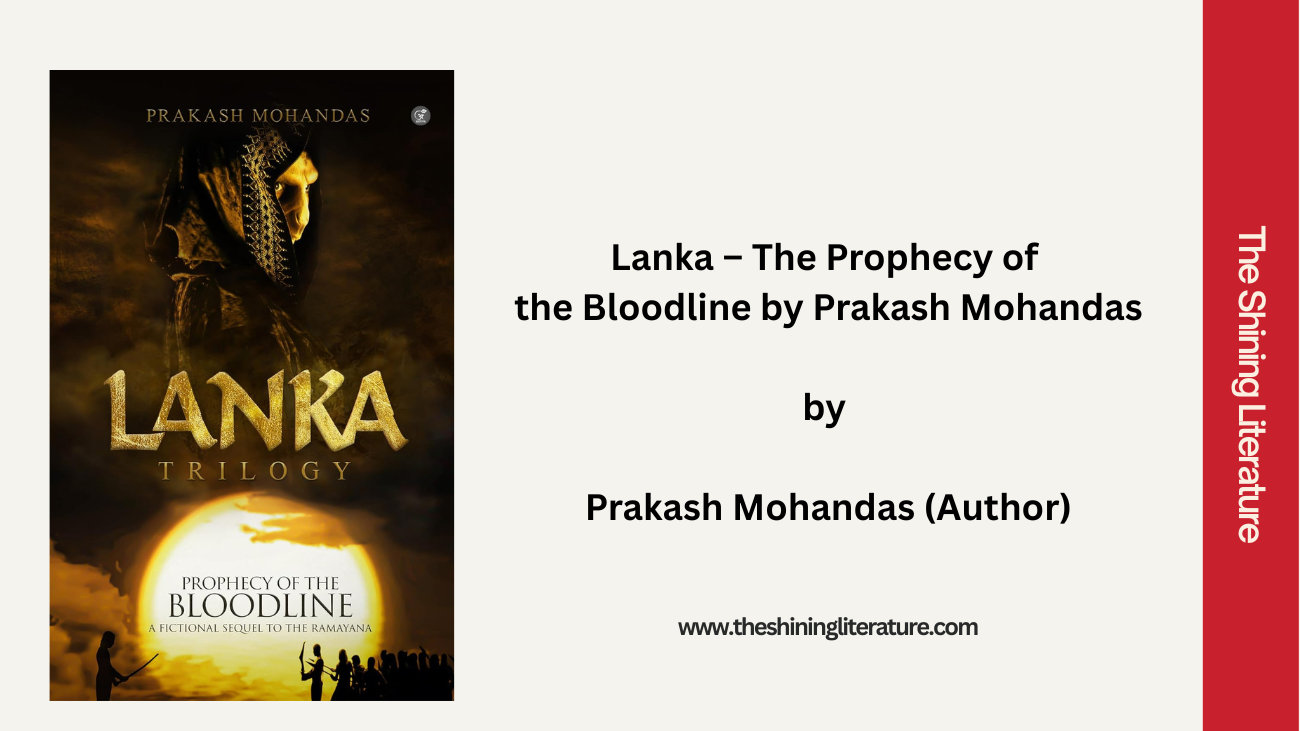Book Review: Lanka – The Prophecy of the Bloodline by Prakash Mohandas
An Epic Reimagining That Dares to Ask – What Came After the Ramayana?
In the rich and complex tapestry of Indian mythology, the Ramayana holds a timeless position. Its characters, values, and divine battle between good and evil have influenced generations. But what if the saga didn’t end with Lord Rama’s return to Ayodhya or Ravana’s fall in Lanka? What if, hidden in the shadows of that epic war, were secrets yet to be told—truths that could redefine how we understand Lanka’s fate and the lineage of Rakshasas?
Prakash Mohandas dares to ask that very question—and boldly answers it in Lanka – The Prophecy of the Bloodline, the first installment of a gripping three-part series. This book is not just a sequel to a mythological event; it is a creative leap into a world filled with intrigue, prophecy, betrayal, and the eternal clash between destiny and free will.
The narrative begins after the great war that decimated Lanka. Ravana is dead, and his noble brother Vibhishana has assumed the throne. Under his rule, a new order begins to emerge—the brave and righteous Rakshasa clan called the Lankans. But this fragile peace doesn’t last long. Enter Shurpanakha, Ravana’s cunning and ruthless sister. In a jaw-dropping twist, we learn that she has been the real mastermind all along. Sita’s kidnapping? Ravana’s death? The war itself? Merely steps in her larger scheme to ascend to power.
It’s a bold reimagining of Shurpanakha—no longer just the woman scorned in the Ramayana, but now a dark, complex antagonist who plays a dangerous game of power and legacy. She imprisons her own brother Vibhishana, banishes the Lankans, and builds a reign of fear with a new faction called the Mayas. Her plan? To secure the prophecy that foretells of a ruler from the true bloodline who will unite the Rakshasas and bring peace. But instead of preventing it, she twists it—intending to birth that prophesied savior herself through carefully calculated choices.
Meanwhile, in the forests where the Lankans live in exile, a spark of resistance glows. Led by Maveera, a powerful warrior and natural leader, the exiled Lankans are visited by the sage Vishwamitra. He brings the ancient prophecy and a path forward: to reclaim what is lost, not just through war, but through identity, unity, and destiny. As the prophecy begins to unravel, questions emerge—Who truly carries the bloodline? Who is the rightful heir to Lanka’s legacy? And most importantly, can a war-weary people rise again to confront the darkness within their own?
What makes Lanka – The Prophecy of the Bloodline so compelling is its layered storytelling. Mohandas doesn’t merely continue the Ramayana; he transforms it. His world-building is immersive, painting a vivid portrait of post-war Lanka with its political factions, deep-rooted betrayals, and spiritual undertones. The pacing is brisk, the tension is high, and the plot twists are well-timed, keeping readers engrossed as they navigate this new mythological terrain.
The characters, too, are skillfully crafted. Shurpanakha, in particular, stands out—not just as a villain but as a symbol of ambition unchecked by conscience. Maveera is equally compelling, representing the exiled hero archetype, yet not without vulnerability. Vishwamitra brings wisdom and mystery, grounding the supernatural elements with his sage-like gravitas.
At the heart of the story lies a deeper exploration of legacy, power, and transformation. The idea of prophecy is not just a plot device—it’s a mirror held up to the characters, forcing them to confront their own truths. Who are we when faced with destiny? Do we follow it blindly, or forge our own path? In this sense, the book goes beyond mythology and enters the realm of philosophical fiction.
Prakash Mohandas’s background in dance, film, and the performing arts shines through in his storytelling. His scenes unfold cinematically—there’s a rhythmic intensity to battles, a lyrical flow in dialogues, and an artistic flair in character descriptions. It’s no surprise that he is also the founder of Agni Dance and Agni Entertainment, as the book reads like a visual epic waiting to be adapted for stage or screen.
Moreover, the author’s intention to promote South Asian narratives through a modern lens is evident throughout the book. He pays homage to tradition while simultaneously expanding the mythos in bold new directions. His reinterpretation of characters like Shurpanakha and Vishwamitra bridges ancient epics with contemporary sensibilities—offering readers not just entertainment but a deeper cultural engagement.
If there is one critique, it’s that the book ends too soon—not in terms of satisfaction, but in leaving you hungry for the next part. It teases a larger universe, an impending war, and truths yet to be unveiled. The tension built in this first installment is masterful, and readers will eagerly await the second and third parts of the trilogy.
In conclusion, Lanka – The Prophecy of the Bloodline is a bold, imaginative, and thrilling reimagining of post-Ramayana events. It blends mythology, fantasy, and philosophy into a gripping narrative that redefines what mythological fiction can be. For lovers of Indian epics, fantasy adventure, and layered storytelling, this book is a must-read. With a gripping plot and thought-provoking themes, it’s not just a story—it’s a prophecy worth following.




